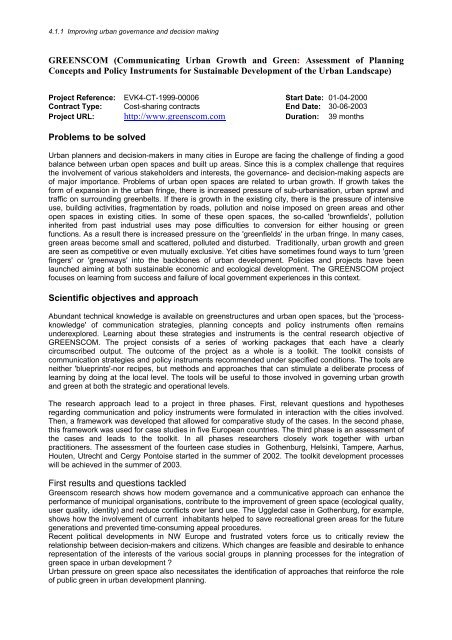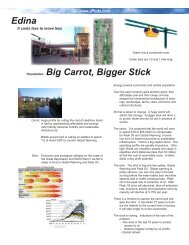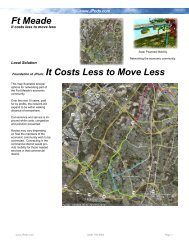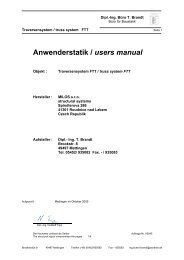FP5 PROJECTS - JPods
FP5 PROJECTS - JPods
FP5 PROJECTS - JPods
Create successful ePaper yourself
Turn your PDF publications into a flip-book with our unique Google optimized e-Paper software.
4.1.1 Improving urban governance and decision making<br />
GREENSCOM (Communicating Urban Growth and Green: Assessment of Planning<br />
Concepts and Policy Instruments for Sustainable Development of the Urban Landscape)<br />
Project Reference: EVK4-CT-1999-00006 Start Date: 01-04-2000<br />
Contract Type: Cost-sharing contracts End Date: 30-06-2003<br />
Project URL: http://www.greenscom.com Duration: 39 months<br />
Problems to be solved<br />
Urban planners and decision-makers in many cities in Europe are facing the challenge of finding a good<br />
balance between urban open spaces and built up areas. Since this is a complex challenge that requires<br />
the involvement of various stakeholders and interests, the governance- and decision-making aspects are<br />
of major importance. Problems of urban open spaces are related to urban growth. If growth takes the<br />
form of expansion in the urban fringe, there is increased pressure of sub-urbanisation, urban sprawl and<br />
traffic on surrounding greenbelts. If there is growth in the existing city, there is the pressure of intensive<br />
use, building activities, fragmentation by roads, pollution and noise imposed on green areas and other<br />
open spaces in existing cities. In some of these open spaces, the so-called 'brownfields', pollution<br />
inherited from past industrial uses may pose difficulties to conversion for either housing or green<br />
functions. As a result there is increased pressure on the 'greenfields' in the urban fringe. In many cases,<br />
green areas become small and scattered, polluted and disturbed. Traditionally, urban growth and green<br />
are seen as competitive or even mutually exclusive. Yet cities have sometimes found ways to turn 'green<br />
fingers' or 'greenways' into the backbones of urban development. Policies and projects have been<br />
launched aiming at both sustainable economic and ecological development. The GREENSCOM project<br />
focuses on learning from success and failure of local government experiences in this context.<br />
Scientific objectives and approach<br />
Abundant technical knowledge is available on greenstructures and urban open spaces, but the 'processknowledge'<br />
of communication strategies, planning concepts and policy instruments often remains<br />
underexplored. Learning about these strategies and instruments is the central research objective of<br />
GREENSCOM. The project consists of a series of working packages that each have a clearly<br />
circumscribed output. The outcome of the project as a whole is a toolkit. The toolkit consists of<br />
communication strategies and policy instruments recommended under specified conditions. The tools are<br />
neither 'blueprints'-nor recipes, but methods and approaches that can stimulate a deliberate process of<br />
learning by doing at the local level. The tools will be useful to those involved in governing urban growth<br />
and green at both the strategic and operational levels.<br />
The research approach lead to a project in three phases. First, relevant questions and hypotheses<br />
regarding communication and policy instruments were formulated in interaction with the cities involved.<br />
Then, a framework was developed that allowed for comparative study of the cases. In the second phase,<br />
this framework was used for case studies in five European countries. The third phase is an assessment of<br />
the cases and leads to the toolkit. In all phases researchers closely work together with urban<br />
practitioners. The assessment of the fourteen case studies in Gothenburg, Helsinki, Tampere, Aarhus,<br />
Houten, Utrecht and Cergy Pontoise started in the summer of 2002. The toolkit development processes<br />
will be achieved in the summer of 2003.<br />
First results and questions tackled<br />
Greenscom research shows how modern governance and a communicative approach can enhance the<br />
performance of municipal organisations, contribute to the improvement of green space (ecological quality,<br />
user quality, identity) and reduce conflicts over land use. The Uggledal case in Gothenburg, for example,<br />
shows how the involvement of current inhabitants helped to save recreational green areas for the future<br />
generations and prevented time-consuming appeal procedures.<br />
Recent political developments in NW Europe and frustrated voters force us to critically review the<br />
relationship between decision-makers and citizens. Which changes are feasible and desirable to enhance<br />
representation of the interests of the various social groups in planning processes for the integration of<br />
green space in urban development ?<br />
Urban pressure on green space also necessitates the identification of approaches that reinforce the role<br />
of public green in urban development planning.








